


OSMOSIS
Osmosis is a condition that affects GRP boats, cars and water tanks and manifests itself by the appearance of blisters between the different layers of the layup.
Polyester resin is slightly porous. Moisture does after a time travel through it and will collect in any voids in the GRP construction. These blisters can be very small, about the size of a half of a hundred and thousand cake decoration, about the size of a split pea or up to the size of half a cherry. Any bigger than this is described by surveyors as being serious delamination.
The problem is caused by many different factors or a combination of a number of factors. Osmosis is more common on vessels used in warm waters or fresh water lakes or rivers. I have seen terrible osmosis in yachts in yards around Lake Geneva. They keep on using them and apart from being a little heavy due to water ingress not much else happens and they are fine to carry on using. Boats used in the Lake District tend to suffer from Osmosis more than vessels found in the cold salt water of England. My own Hurley has bad osmosis in its water tank and also under any areas of Treadmaster decking. This is where warm rainwater has collected. I carry on using the water tank and don't notice a lot of smell. I use plastic containers of water from Tesco to drink or brush my teeth.
Reasons for osmosis.
-
Failure to mix the resin and catalyst together properly during manufacture which creates pockets of uncured resin;
-
Leaving the layers to cure for too long between coats of resin. For example over night or over a weekend;
-
Poor attention to humidity levels in the workshop where the boat was layed up. If condensation is allowed to form between the layers the gelcoat or resin will not adhere properly;
-
Poor levels of cleanliness in the workshop. Contamination by dust etc.
So the moisture travels through the one or two layers of gelcoat (resin and pigment) towards the layers of matting or woven rovings which are wetted in with resin. The moisture collects in pockets and creates areas of high pressure, i.e. the chemicals in the dissolved resin mix with water to form a mixture that has a higher pressure than that of the water outside the hull. Osmosis is often most evident when a vessel is first taken out of the water. If the sun is strong the warmth will increase the volume of the water in the blister pockets and make it expand. The blisters will become larger. If you burst a proper osmotic blister you might be able to smell acetic acid. You should taste it too by rubbing your finger into the blister. The acetic acid is a product of the styrene and acetone used as solvents in the resin.
Osmosis is commonly found on boats from the mid-seventies, which was around the time of the oil crisis. Boat builders were experimenting with alternative types of synthetic catalysts to save money. Not all worked. Lucky for us Hurley used standard isophthalic resins which were of good quality and the boats were well made.
Modern boats are built in workshops where humidity is controlled. Boat builders work throughout the clock to ensure that curing and layering times are kept precise. Resins are now advanced. However, USA and Canadian boats can suffer as their governments have forced boat builders to reduce styrene levels by using alternative resins.
If you go Emsworth Harbour near Chichester you will see lots of almost new Trader motor yachts being treated for osmosis under warrantee. Emsworth is shallow, the water is warm and brackish. Same thing happens to boats in Christchurch. There are loads of Westerly Centaurs in Christchurch. Many suffer from osmosis but don't come to come to any real harm. The owners just antifouled over the blisters.
Alternatives. What to do.
-
Ask a surveyor who is passing how bad the blisters are and ask him or her to check moisture content.
-
If the blisters are small or the vessel is of low value then just carry on using the boat as if nothing had happened.
-
Monitor the blisters each year. Take photographs and record moisture levels. However, the moisture levels will change depending on atmospheric conditions and should be taken as a relative reading against the reading taken of the topsides above the waterline. Typically three or four times higher below that waterline compared to above is normal. Typically a Sovereign meter the reading above would average 4 and below would be between 14 and 19. This would be fine for a Hurley but wet for a newer boat or a Motorboat. A condition called wicking might occur where moisture 'wicks' up through the glass fibres to the topsides and creates small blisters around the waterline. This is not a great problem.
Cures.
-
Do nothing and carry on using the boat knowing that the value of the boat might be affected;
-
Remove the gelcoat by pealing it off by a hired plane type device, by having it slurry blasted of or scraping it off with a scraper and hot air paint stripper. This last way is messy, might damage the laminate, might poison you with fumes or might set fire to the boat but is cheap.
You will need to remove all of the gelcoat and allow the hull to dry for a very long time until the moisture levels fall to about the same below the waterline compared to what they are above the waterline. This will take up to nine months but depends on climate. Drying times can be speeded up by using infra red lamps or de-humidifiers but this is expensive. It is not a good idea to paint epoxy resin onto a damp hull. This will just trap moisture in and cause the lay-up to delaminate. If this happens the structure will be scrap. Epoxy resin should be applied to a dry hull stripped of gelcoat or you will be wasting your money.
This is a simplistic explanation of osmosis. There will be lots of folk who will disagree as it is a very contentious issue.More about why boats aren't just built of epoxy resin later. That is a different story.
Nick
Osmosis treatment of Hurley 24 'Circe'
Click on a picture to see a larger version
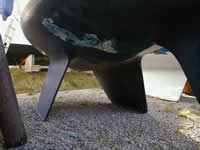 |
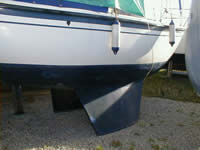 |
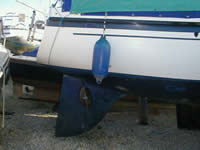 |
|
Before treatment and blasting |
||
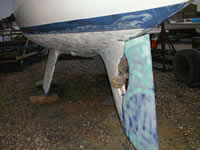 |
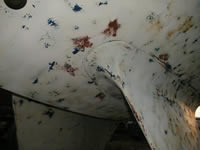 |
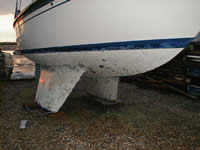 |
|
The pictures above were taken just after she was grit blasted to remove all the paint etc |
||
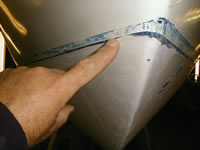 |
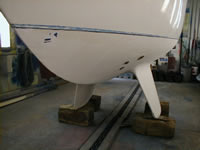 |
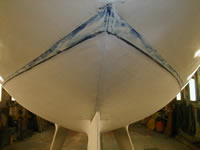 |
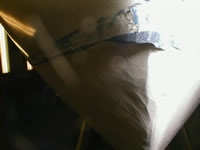 |
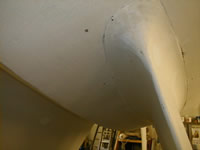 |
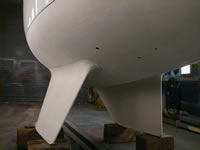 |
|
The above were taken after she was peeled |
||
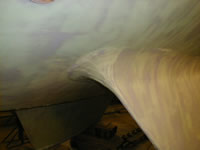 |
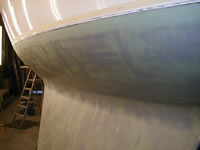 |
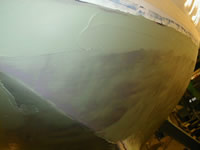 |
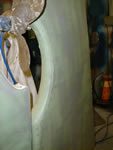 |
|
First coat of the new gel coat |
|||
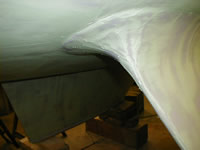 |
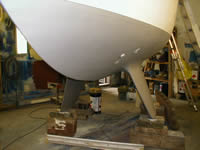 |
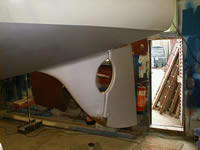 |
|
|
First coat of the new gel coat |
After treatment and coated with primer ready for anti-fouling |
||
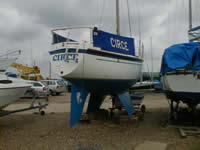 |
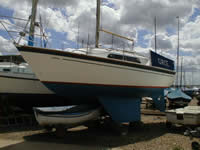 |
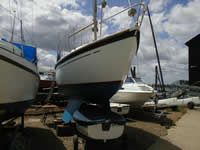 |
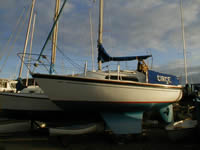 |
|
The final result |
|||
Thanks to Stuart Shaw for supplying the pictures
Back to Technical